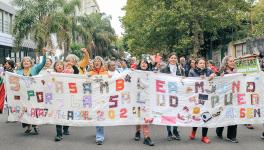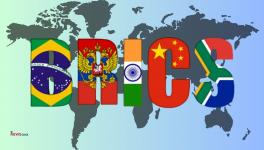Brazilian Elections: What Happens Next?
Sunday’s elections in Brazil were surprising to some and predictable to others. This is inevitable, considering Brazilians voted for president, national legislature and senate, state legislature, and state governor and had a plethora of political parties and candidates to choose from. The international focus, however, was on the presidential results, as president Dilma Rousseff from the Workers’ Party (PT) took just over 40 percent of the valid votes and will compete in the second round against right-winger Aécio Neves (PSDB), who received just over 33 percent of the votes. Given this result, one of the main questions is: What happened to Marina Silva (PSB)?
The Presidential Race
The meteoric rise of Marina Silva as Rousseff’s main opponent midway through the campaign period called for the PT and the PSDB to reorganize themselves around their candidates, something new considering elections historically were always led by these two parties. However, as it was verified this Sunday, the Silva phenomenon was set to lose steam after the novelty of a third major candidate wore off. Silva, who has traded parties a few times in the recent past and is in the process of founding her own party, promoted herself as the alternative the Brazilian people were looking for; a clever framing considering the general feeling of a crisis of representation in the protests of June 2013. Silva’s mistake was to believe that this alternative had to be post-ideological and technocratic, forwarding that post-politics was the answer to this crisis of representation. What she did not foresee was that depoliticization is what diverted June 2013 from becoming a significantly revolutionary moment in Brazilian history, and, therefore, her own attempt to depoliticize the electoral race would too suffer from a quick rise and fall.

Image Courtesy: http://upsidedownworld.org
In addition to her own following, Silva was counting on the votes from both disaffected left-wing and right-wing voters. However, her apparent neutrality and objectivity beyond ideology failed to captivate these voters, who soon returned to their original choices. The right-wing voters acknowledged the similarities between Silva and Neves, but likely opted for the more consistent stance of the PSDB on neoliberalism and conservative themes. Those on the left, on the other hand, either migrated back to Rousseff and the Workers’ Party, or found themselves a new candidate. Here, it is important to highlight the performance of Luciana Genro, presidential candidate from the Socialism and Freedom Party (PSOL), whose votes were almost double the PSOL results in the previous election. As the only candidate from the radical left parties (which also include the PCB, the PSTU, and the ultra-left PCO) to appear in the major televised debates, Genro had a difficult task. She had to reveal the inconsistencies and programmatic problems of both the Neves and Silva candidacies, while providing an important critique of the many errors of the PT administrations under Lula and Rousseff from a leftist perspective. Primarily, Genro had to appeal to the progressive voices of June 2013 mobilizations who had not yet found a political party of their own or who were tempted to annul their votes. Since voting in Brazil is compulsory, annulled votes are usually perceived as protest votes, or a way to expose that the electoral process is flawed and has failed to produce suitable representatives. Some anarchist and/or anti-party collectives that grew out of the June 2013 mobilizations even promoted vote annulment campaigns, under the banner of “Don’t vote! Fight for the revolution!” Despite these efforts, the percentage of annulled votes in the presidential race was not much higher than in the 2010 election, at just under six percent.
Odd Alliances and the Lack of Good Ones
This voting breakdown shows that despite the crisis of representation made evident in June 2013, Brazilian voters are still willing to make a choice at the voting machine. More than a crisis of representation, Brazil has a crisis of political praxis that has evolved from a consistent process of depoliticization that splits political themes from each other and prevents a more coherent political project. This is why there are voters who choose candidates from opposing political camps for different offices, making it possible to have both Marcelo Freixo (PSOL) and the conservative Jair Bolsonaro (PP) be the highest voted state congressman and federal congressman for Rio de Janeiro, respectively. The electoral sphere in Brazil is also inconsistent given the variety of coalitions between the many political parties in order to guarantee a few seats for the small parties or in exchange for bureaucratic positions. Electoral coalitions also vary according to the state and office in question, so that it is possible for PSDB and PSB to compete with their own candidates Neves and Silva at the presidential level, but partner at the state level in São Paulo to re-elect Geraldo Alckmin (PSDB) as governor. Alckmin, who won with 57.3 percent of the votes, is re-elected at a critical time for São Paulo, as the state faces the possibility of major water supply shortages. The fact that the connection between the shortages and his administration, as well as his promotion of police brutality and criminalization of social movements, did not prevent this victory suggests that elite ideology is very much alive in parts of Brazil. The same can be said for other states such as Goiás, Rio de Janeiro, Paraná, and the Federal District (Brasília) where conservative coalitions received significant support.
While the PT is no stranger to contradictory party coalitions (evident in the mix of eight political parties in its presidential coalition), the radical left parties opted to run their own candidacies in a variety of states and at all levels. The absence of a major alliance in the shape of a Leftist Front at the national level not only indicates the presence of strong methodological and programmatic divergences in the radical left, but has also led to more open disputes that may have deepened its fragmentation. For instance, the separate candidacies put the candidates Mauro Iasi (PCB) and Zé Maria (PSTU) at a disadvantage, considering that their parties had no parliamentary representation, which negatively affected their television time and their ability to participate in the major debates. Because of its parliamentary representation, PSOL was better able to promote Genro (PSOL) and the party also grew, even if modestly, through legislative victories at the federal and state levels. One must ask, however, about the need to build a true Leftist Front with the three parties in order to more effectively advance a socialist political project. For Iasi, a Leftist Front must be a priority, although not in the shape of rushed electoral coalitions. The PCB candidate has argued for a more organic process of dialogue and negotiation with the PSTU and the PSOL in the future, which should also include non-electoral actors such as labour unions, social movements, and the vast youth movement that has grown since June 2013.[1]
The Left and the PT
The objective behind a Leftist Front would be to build a real alternative to the PT and its neoliberal ways from a radical left perspective. This opposition would have to translate in electoral gains in order to build a radical left mass movement at the institutional level. The current opposition of the radical Left to the PT has already presented its challenges, since PT members and intellectuals accuse these parties from favoring the Right through their criticism, especially during elections. There is still a widespread belief in strong sections of the Brazilian left from parties to social movements that the PT should remain in power and lead the way against right-wing advances. This belief tends to emphasize the social conquests of PT administrations, such as the Bolsa Família conditional-cash transfer program, while excusing failures such as the absence of agrarian reform on the basis of unfavorable conditions.
While the radical left works to fix its own fragmentation, it must also consider what to do in relation to the final run-off between Rousseff (PT) and Neves (PSDB) at the end of the month. This has always been a delicate moment for those in opposition to the PT from a leftist standpoint, as strategic support and valid criticism have to be negotiated in order to deter support for the right-wing candidate. This is also a delicate moment for the PT, as its ambiguous position in Brazilian politics requires both a leftist and a centrist appeal. To do so, the PT has to embrace the value of any reserved support from the radical left as recognition of its working-class roots. At the same time, it has to battle the heavily ideological terrain of “anti-PT” sentiment that surrounded many of Silva’s voters who may join Neves this time around. This electoral dance is something the party is already used to, although, for the sake of radical social change, it may be better if it were less proficient at it. For those fighting for matters of social and identity rights, agrarian reform, indigenous rights, the right to the city, quality socialized public services, police demilitarization, the end of the war on drugs, media democratization, effective political reform, and no more criminalization of social movements, the PT, as it stands today, is not an option. Therefore, this second round of presidential votes calls for the lingering questions of the past 12 years: can the PT be rescued? And what can we do about it right now?
Sabrina Fernandes is a PhD Candidate in Sociology at Carleton University. She is also an activist in the Brazilian radical Left (https://www.facebook.com/sabrinafernandesphd)
Disclaimer: The views expressed here are the author's personal views, and do not necessarily represent the views of Newsclick
Get the latest reports & analysis with people's perspective on Protests, movements & deep analytical videos, discussions of the current affairs in your Telegram app. Subscribe to NewsClick's Telegram channel & get Real-Time updates on stories, as they get published on our website.
























